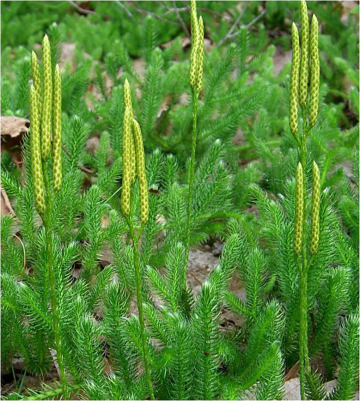Life Cycle and Morphology of Lycopodium: A Comprehensive Overview
Introduction to Lycopodium: Lycopodium is a genus of spore-bearing vascular plants commonly known as clubmosses. These plants belong to the family Lycopodiaceae and are part of the Lycopodiophyta division, a primitive group of vascular plants. Lycopodium species are found in various habitats, ranging from moist forests to arid environments. They are characterized by their small, herbaceous nature and unique reproductive structures.
Some species of Lycopodium:
- Lycopodium clavatum (Stag's horn clubmoss)
- Lycopodium annotinum (interrupted clubmoss)
- Lycopodium obscurum (round pine)
- Lycopodium complanatum (Eastern Tree Clubmoss)
- Lycopodium inundatum (Marsh clubmoss)
Morphological Characteristics (up to 10):
- Stem: Lycopodium plants typically have an underground rhizome and an above-ground, branching stem.
- Leaves: Microphyllous leaves are arranged spirally along the stem, each with a single unbranched vein.
- Strobili: Reproductive structures are cone-like structures called strobili or sporangia.
- Sporophylls: The sporophylls, or modified leaves that bear sporangia, are aggregated into the strobili.
- Rhizome: The underground rhizome serves as a storage organ and produces adventitious roots.
- Roots: Lycopodium plants have simple, dichotomously branching roots.
- Sporangia: Spores are produced in sporangia, which are borne on the sporophylls.
- Epidermis: The epidermis of the stem contains stomata, allowing gas exchange.
- Vascular Tissues: Lycopodium possesses primitive vascular tissues (xylem and phloem).
- Ligules: Some species have ligules, small appendages on the upper surface of the leaf.
Differences from Psilopsida (Whisk Ferns): Lycopodium belongs to the Lycopodiophyta division, while Psilotum belongs to the Psilotophyta division. Here are some key differences:
- Psilotum lacks true roots and leaves, whereas Lycopodium has true roots and microphyllous leaves.
- Psilotum lacks vascular tissue, while Lycopodium has primitive vascular tissue.
- Lycopodium produces spores in specialized structures (sporangia) on sporophylls, while Psilotum produces spores in sporangia that are not aggregated into cones or strobili.
Sporangium and its Development Process in Detail:
- Sporangium Formation: Sporangia are typically found on the upper surface of modified leaves called sporophylls. They develop within the strobilus, or cone-like structure.
- Development Process: The sporangium undergoes several stages of development, including cell division and differentiation. The process involves the formation of sporogenous tissue, which gives rise to spore mother cells. These cells undergo meiosis to produce haploid spores.
Types of Spores and Their Germination:
- Types of Spores: Lycopodium produces homosporous spores, meaning all spores are of the same size and sex.
- Germination: When conditions are suitable, the spores germinate to form a small, green photosynthetic structure known as the gametophyte.
Development of Male Gametophytes:
- Gametophyte Formation: The spore germinates to form a male gametophyte, also known as a prothallus.
- Antheridia: Antheridia, the male reproductive structures, develop on the gametophyte.
- Sperm Formation: Antheridia produce sperm cells through mitosis.
Development of Female Gametophytes:
- Gametophyte Formation: The spore germinates to form a female gametophyte.
- Archegonia: Archegonia, the female reproductive structures, develop on the gametophyte.
- Egg Formation: Archegonia produce eggs through mitosis.
Fertilization, Zygote Formation, and Germination:
- Fertilization: Water is necessary for the sperm to swim to the archegonium, where fertilization occurs.
- Zygote Formation: Fertilization results in the formation of a diploid zygote.
- Embryo Development: The zygote develops into an embryo within the archegonium.
- Germination: When conditions are favorable, the embryo undergoes germination, giving rise to a new sporophyte, thus completing the life cycle.
This life cycle, involving the alternation of generations, is a common feature in plants, including Lycopodium. The haploid gametophyte generation alternates with the diploid sporophyte generation.




.jpg)
2 Comments
1300
ReplyDeleteIqra Jahangir 1300
ReplyDelete